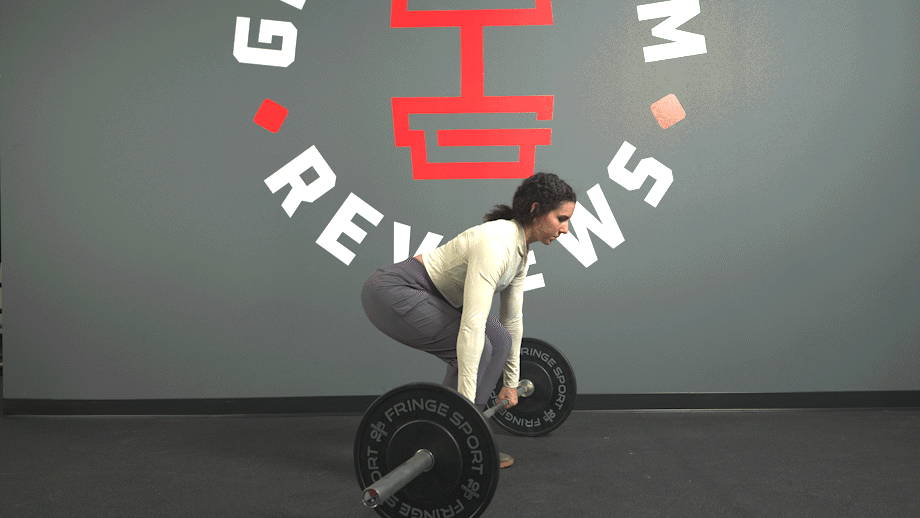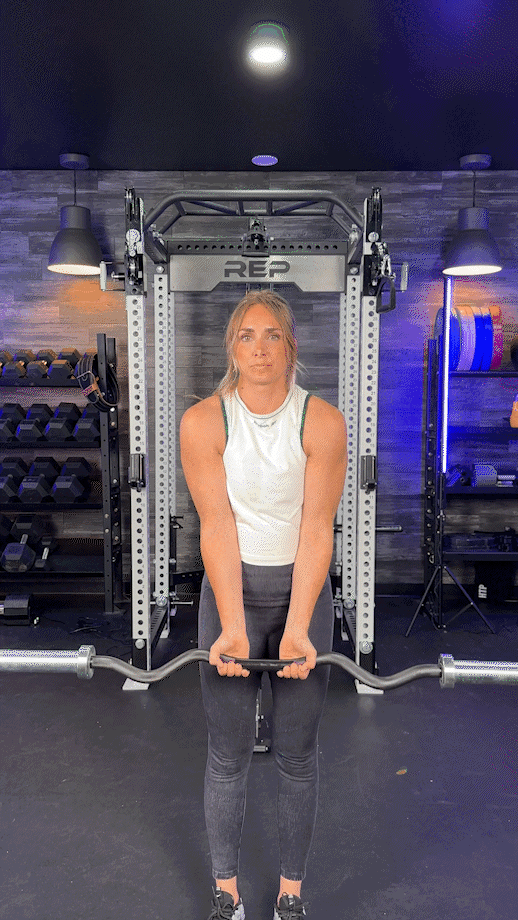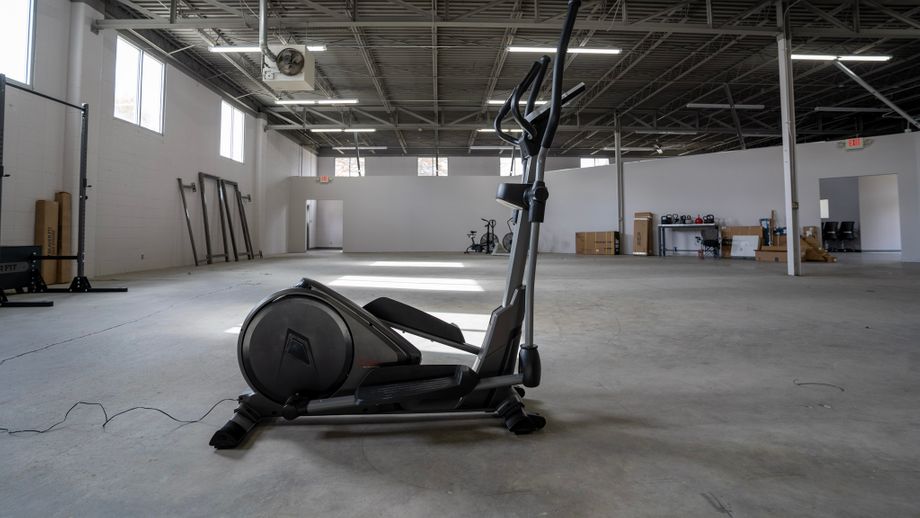Full-body barbell workouts are designed to trigger muscle-building and drive your fitness journey to new levels. Whether you’re a seasoned fitness enthusiast or just stepping into the world of weights, these comprehensive routines promise to challenge every muscle group, fostering full-body strength, muscle size, and endurance.
As a Certified Strength and Conditioning Specialist (CSCS), I took the time to hand-pick my favorite movements to provide you with an exciting yet challenging full-body barbell workout. With a focus on compound movements and strategic exercises, this regimen is meticulously crafted to maximize gains and optimize your strength-building potential.
RELATED: Full-Body Compound Workout
Hit these routines the next time you train—whether at the gym or at home in your decked-out garage—and I promise you’ll take note of why these full-body barbell exercises carry so much notoriety.
Benefits of Full-Body Barbell Workouts
Here are my top three benefits of utilizing full-body barbell workouts in your training routine.
Training Efficiency
Compound exercises offer unparalleled efficiency by engaging multiple muscle groups in a single movement, driving more significant strength increases than their single-joint counterparts. A December 2017 study published in Frontiers of Physiology1 found that increases in strength measurements were greater for multi-joint exercises compared to single-joint exercises. These exercises mirror real-life movement, enhancing functionality and activating stabilizer muscles to boost stability and balance in the entire body. Incorporating compound movements into your full-body barbell workouts ensures an integrated approach to training, reaping many benefits for strength, functionality, and overall fitness.
Versatility
Barbell training offers versatility in your workouts as it’s an adaptable training method that caters to all fitness levels and allows exercise variation throughout your program. Barbell movements are not limited to one type of exercise or muscle group, benefitting from the qualities of compound exercise training. You can train your upper or lower body, different movement patterns, and even use full-body exercises—like the thrusters workout—with barbell training.

Strength Gains
To truly improve your strength, heavy lifting becomes essential. While dumbbells and kettlebells offer fantastic training options, their limitations in maximum weight capacity restrict the potential for absolute strength gains. For strength training, a low repetition scheme with heavy loads2—1 to 5 repetitions per set with 80% to 100% of your one-repetition maximum (1RM)—optimizes strength increases.
RELATED: Full-Body Kettlebell Workout
It’s crucial to vary your loads and not constantly lift heavy to prevent plateaus, yet integrating dedicated blocks of barbell-focused training into your program helps create opportunities to push your strength to new heights.
The Movements
The benefits above were just the appetizer; for the entrée, here’s a list of my favorite exercises to include in a full-body barbell workout, followed by three goal-based example workouts. Don’t worry if you are unfamiliar with any of these movements; I’ve provided step-by-step instructions.
Back Squat
Why do it: Snag one of the best budget barbells and get to squatting! Back squats reign supreme for lower-body barbell exercises. Adding back squats to your routine helps craft a functional, full-body barbell workout that engages your quads, glutes, hamstrings, core, and upper back.
How to do it:
- Position your hands just outside shoulder width.
- Step under the bar, squeeze your traps, and position on your upper back against the bar.
- Step back and stand firmly with your feet hip-width apart.
- Brace your core, then bend at your knees to descend until your quads are parallel to the floor (aim for 90 degrees).
- Drive through your heels with control to stand back up.
- Repeat for desired sets and reps.
RELATED: Lower-Body Workouts

Conventional Deadlift
Why do it: The conventional deadlift is undeniably effective in improving muscle strength and size. It’s a fundamental and functional compound exercise that develops your hamstrings, glutes, lower back, and core. Want to get bigger, faster, and stronger? Training with the deadlift is a must!
How to do it:
- Start with feet shoulder-width, toes under the bar.
- Hinge at your hips and knees, gripping the bar just outside your legs.
- Engage your core, keep your chest up, and straighten your back.
- Lift by pushing through your heels, straightening your legs, and driving your hips forward. Keep the bar close to your body.
- Stand tall, pause, then lower the bar by bending your hips and knees.
- Control the descent and repeat.
Expert tip: Stay tight from start to finish of the deadlift to have great form and prevent injury.
RELATED: How to Deadlift Heavier

Bench Press
Why do it: Ah, the legendary bench press! Find yourself on one of the best weight benches, repping out this powerhouse of an upper-body move in your full-body barbell workouts. The bench press targets the pecs, triceps, and shoulders. Want to drive even more muscle growth? Try out these variations: close-grip, pause, tempos, and incline.
How to do it:
- Lie flat with the barbell above your chin and feet flat.
- Place your hands at shoulder-width, gripping the barbell.
- Brace your core, and push the bar off the rack.
- Bend your elbows and lower the bar to your chest.
- Drive the bar straight up to lockout.
- Repeat for desired sets and reps.
RELATED: Close-Grip Bench Press

Standing Overhead Press
Why do it: One-fourth of the Big 4 barbell exercises (shout out to the squat, deadlift, and bench press) the standing overhead press develops upper body size and strength.
How to do it:
- From standing, grab the barbell with an overhand grip, placing your hands just outside of shoulder-width and keeping your elbows up.
- Press the barbell overhead to lockout.
- Slowly lower the bar back to the starting position or rack.
- Repeat for desired sets and reps.
Expert tip: If you’re looking to develop upper body power, check out the push press exercise.
RELATED: Best Shoulder Exercises

Barbell Lunges
Why do it: Keeping it short and sweet, the lunges exercise is awesome! It’s incredible for training single-leg strength and stability, core strength, and getting your glutes fired up. Don’t settle for just one type of lunge pattern; explore the world of lunge variations: front, reverse, lateral, pendulum, and more!
How to do it:
- Stand tall, feet hip-width apart, toes forward with the barbell loaded on your upper back.
- Step forward with your left foot and lower your right knee near the floor.
- Push through your left foot to return to the starting position.
- Alternate sides for maximum reps.

Romanian Deadlift
Why do it: Romanian deadlifts focus on engaging the lower back, glutes, and hamstrings, enhancing flexibility and mobility across your posterior chain. Whether at the gym or in your home garage setup, an RDL workout is one of the most effective hip hinge exercises for a strong lower body and improved overall functional movement.
How to do it:
- Grab the barbell with a shoulder-width overhand grip.
- Position your feet hip-width apart, flat against the floor.
- Lift the barbell to standing.
- Hinge by unlocking your knees and pushing your hips back. Keep the bar close to your lower body as your chest leans forward.
- Lower the bar slowly until you feel your hamstrings stretch. Then drive your heels into the ground and your hips forward (without hyperextending your back) to return to the starting position.
- Repeat for desired reps.

Barbell Biceps Curl
Why do it: Welcome the CEO of the JACKED, Inc.: the barbell biceps curl. This curl variation is the cornerstone for building bicep strength and size, isolating and effectively targeting the muscles in the front of your upper arms.
How to do it:
- Stand with your feet hip-width apart.
- Hold a barbell with an underhand grip.
- Curl the bar toward your shoulders.
- Slowly lower the barbell back to the starting position.
- Repeat for desired reps.

Hang Power Clean
Why do it: Using one of the best Olympic barbells, hang power cleans unlock your power potential—explosive by nature, fast by intent! Working this movement from a hang position limits your room for error, allowing the focus to shift toward speed execution.
How to do it:
- Overhand grip the barbell, with your arms about shoulder-width apart.
- Bring the barbell to your hips and squeeze your core.
- Keep the bar close and lower it above your knees.
- Drive your legs and explode the weight up.
- Catch in a quarter-front squat position. Then extend your hips and knees.
- Return to the starting position and repeat for desired sets reps.
RELATED: Explosive Workouts

Barbell Bent-Over Row
Why do it: The barbell row trains your lats and shoulders, making it one of the best barbell exercises for developing mid and upper back muscle mass. Make it a superset by combining the barbell row with any pressing movement, such as bench press or overhead press, for a killer one-two punch.
How to do it:
- Hinge forward to set up, keeping your back straight.
- Overhand grip the barbell, with your arms shoulder-width apart.
- Squeeze your lats, and row the barbell toward your chest.
- Lower the barbell back to the starting position.
- Repeat for desired sets and reps.
RELATED: Superset Workouts

A Total Full-Body Barbell Workout
Check out my handcrafted full-body barbell workouts that harness the benefits of muscle-building compound exercises.
Strength
| Exercise | Rounds | Reps |
| A1. Barbell Conventional Deadlift | 3 | 4-6 reps |
| A2. Barbell Bench Press | 3 | 9-12 reps |
| B1. Barbell Back Squat | 3 | 4-6 reps |
| B2. Barbell Bent-over Row | 3 | 9-12 reps |
| Strength Finisher | EMOM | Reps |
| C1. Standing Barbell Overhead Press | 5 min. | 3 reps |
Note(s): Letters (i.e. A1., A2.) indicate a superset. So, you’ll be performing 3 rounds of the barbell deadlift immediately followed by the bench press before moving on to the next group of exercises (B1., B2.).
EMOM stands for Every Minute on the Minute, which means you’ll be performing 5 rounds of 3 reps with the remainder of each minute as your rest time between rounds. All rounds should use the same weight.

Hypertrophy
| Exercise | Rounds | Reps |
| Barbell Lunge | 4 | 8-12 reps, per side |
| Barbell Bent-Over Row | 4 | 8-12 reps |
| Romanian Deadlift | 4 | 8-12 reps |
| Standing Barbell Overhead Press | 4 | 8-12 reps |
Note(s): Perform these four exercises as a giant set with no rest between exercises, and 60 to 90 seconds rest between rounds. You’ll need that rest, but you’ve got to earn it first!
Power
The key for any power workout is to move lighter loads FAST and lower the number of reps.
| Exercise | Rounds | Reps |
| A1. Hang Power Clean | 4 | 3 reps |
| A2. Bench Press | 4 | 3-5 reps |
| B1. Barbell Conventional Deadlift | 3 | 3-5 reps |
| B2. Standing Barbell Overhead Press | 3 | 3-5 reps |
Note(s): Letters (i.e. A1., A2.) indicate a superset. So, you’ll be performing 3 rounds of the hang power clean immediately followed by the bench press before moving on to the next group of exercises (B1., B2.).
Full-Body Barbell Workout: Final Thoughts
Full-body barbell workouts have several benefits; the overall winner—in my expert opinion—is that they can help you make every rep count, especially when you focus on incorporating compound movements and strategic exercise pairings. My CSCS-approved workouts and technique tips are here to help get you started if you’re looking to add more barbell-focused full-body training to your weekly training regimen. Happy lifting!
Full-Body Barbell Workout: FAQs
Can I build muscle with just a barbell?
Absolutely! A barbell is a versatile and vital tool for muscle building. It allows you to perform various compound exercises targeting multiple muscle groups simultaneously. Focus on compound exercises that engage large muscle groups to maximize muscle building with a barbell, like squats, deadlifts, bench presses, rows, and overhead presses.
RELATED: Barbells vs. Dumbbells
What are the big four barbell exercises?
The Big Four barbell exercises are squats, deadlifts, bench presses, and shoulder presses. These four weightlifting movements are staples in most strength training programs, capitalizing on compound exercises and training multiple muscle groups simultaneously. They also happen to be a few of the best options for building strength in the gym (or garage).
RELATED: Best Home Gym Equipment
How often can you do a full-body barbell workout?
Aim for two to three training days per week to achieve the best results from full-body barbell workouts. Full-body workouts target multiple major muscle groups, requiring effective warm-ups and adequate rest before your next training day. Focus on mobility exercises, nutrition, and hydration to ensure you’re ready for your workout!
What is the best barbell exercise for building muscle?
As an experienced performance coach, I’ve found the conventional barbell deadlift to be the best barbell exercise for building muscle. It’s a simple full-body exercise to learn and implement in a workout program. It has exceptional carry-over to functional movements of daily life, promotes size and strength in the upper and lower body, and can be used in various ways – tempos, pauses, and even chain or banded variations.
RELATED: Deadlift Muscles Worked
What are the benefits of a full-body workout?
Full-body workouts can help improve your muscle size, strength, and cardio capacity. Beyond these physical gains, they capitalize on time efficiency in the gym. My time as a certified personal trainer (CPT) has taught me to prioritize full-body training for its ability to deliver comprehensive workouts in limited time frames when working with clients or athletes. Don’t limit full-body training to only being done via bodyweight workouts. Toss in a barbell, a pair of the best dumbbells, or kettlebells for incredible results.
References
- Paoli A, Gentil P, Moro T, Marcolin G, Bianco A. Resistance Training with Single vs. Multi-joint Exercises at Equal Total Load Volume: Effects on Body Composition, Cardiorespiratory Fitness, and Muscle Strength. Front Physiol. 2017;8:1105. Published 2017 Dec 22. doi:10.3389/fphys.2017.01105
- Schoenfeld BJ, Grgic J, Van Every DW, Plotkin DL. Loading Recommendations for Muscle Strength, Hypertrophy, and Local Endurance: A Re-Examination of the Repetition Continuum. Sports (Basel). 2021;9(2):32. Published 2021 Feb 22. doi:10.3390/sports9020032






